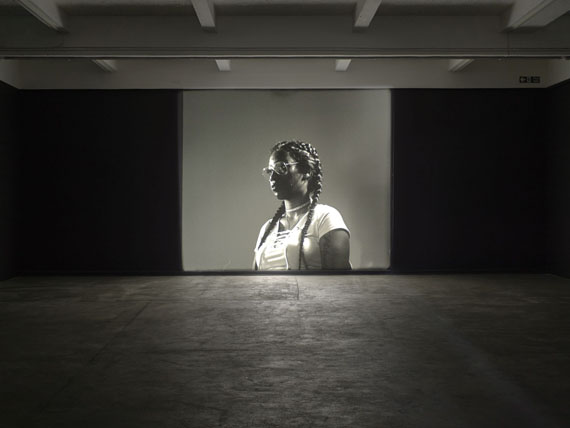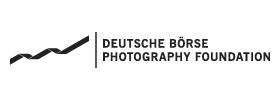
Commissioned by Chisenhale Gallery and produced in partnership with Create
Courtesy of the artist, Photo: Andy Keate
Luke Willis Thompson »
Winner Deutsche Börse Photography Foundation Prize 2018
Exhibition:

Deutsche Börse Photography Foundation
Mergenthalerallee 61
65760 Eschborn
+49 (0)69-21 11 40 60
foundation@deutsche-boerse.com
deutscheboersephotographyfoundation.org/
by app. only
Luke Willis Thompson was announced as the winner of the Deutsche Börse Photography Foundation Prize 2018 for his project autoportrait at a special evening ceremony held at The Photographers’ Gallery, London on Thursday 17 May.
The award was presented to Thompson by BBC broadcaster and journalist, John Wilson.
First shown at Chisenhale Gallery, London, 23 Jun – 27 Aug 2017, autoportrait presents a ‘collaborative’ and silent filmic portrait of a young US woman, Diamond Reynolds.
Reynolds was catapulted into the media spotlight after she live streamed the moments immediately following the fatal shooting of her partner, Philando Castile, by a police officer during a routine traffic stop. It immediately went viral, amassing over 6 million views and adding to the ever-increasing catalogue of self-shot footage exposing police brutality towards people of colour. With their four-year-old daughter in the back seat of the car, Reynolds’ almost simultaneous documentation feels like an instinctive act of preservation and justice seeking. Of her decision to both film and post the footage she said, “Because I know that the people are not protected against the police, I wanted to make sure if I died in front of my daughter, people would know the truth.” And yet, while the clip undeniably contributes towards a growing call out of such injustices, it also illustrates how an intensely personal moment of indescribable grief and terror can so rapidly become public property, shared, reframed and harnessed beyond control.
Continuing personal and artistic concerns around widespread police violence and prejudice – as well as an ongoing interest in the way images can now be circulated without reference permission or recourse – Thompson contacted Reynolds via her lawyer with a proposal to make a ‘sister image’; a counterpoint to the one circulating beyond her control as a way to return her agency and address some of the subsequent issues arising.
Agreeing to the project, Reynolds collaborated closely with Thompson over every aspect of the film, right down to choosing what she wore, how she was framed and lit, and from what angle. Shot in 35mm Kodak Double-X black-and-white film in two four-minute, almost completely static takes, Reynolds is cloaked in silence and private meditation. She appears unaware of the camera, and by default the spectator. Presented in a darkened room, silent, apart from the whirring of the large-scale projector, autoportrait presents an environment that is at once both intimate and communal. The space is hers and presents a self-aware, uninterrupted moment of reflection, rebutting the frenzy of the ‘real’ moment and its rapid spiral into the public realm.
autoportrait was conceived as another way to offer a riposte to what Thompson has termed the ‘perverse’ genre of witness videos. He has imposed strict conditions over the presentation and distribution of the project. No element is reproducible without consent. It exists as an analogue piece only, without a digital equivalent. Thompson intends for the work be viewed only in the context it was created for: a blacked out room with the projection as the only light source, so all attention is given over to the barely-moving image. That the film is without sound is another vital component of its existence, representing the ‘lack of voice’ given to both victims of crime and injustice and those that don’t survive it;
Speaking on behalf of the panel, TPG Director and DBPFP18 Chair of Jury, Brett Rogers said, “As a contender for a prize focused on photography, the jury felt autoportrait imbued the moving image format with the singular, almost obsessional quality of a still photograph, drawing attention to its materiality, and challenging viewers to consider the personal stakes of representation in an environment at once intimate and collective. Ultimately though, the project was felt to invite a timely and prescient conversation around the nature of image control, authorship and distribution in a way that expands rather than shuts down the debate.”
The 2018 panel consisted of Anne-Marie Beckmann, Director, Deutsche Börse Photography Foundation; Duncan Forbes, Curator and visiting research Fellow at the Westminster University; Gordon MacDonald, Artist, Curator and Editor; Penelope Umbrico, Artist. Brett Rogers was the non-voting chair.
The 2018 shortlist comprised Mathieu Asselin, Rafal Milach, Batia Suter and Luke Willis Thompson, all of whose nominated projects will remain on display at The Photographers’ Gallery until 3 June 2018.�
Gewinner Deutsche Börse Photography Foundation Prize 2018
Luke Willis Thompson
Der Deutsche Börse Photography Foundation Prize 2018 ist am Donnerstag, 17. Mai 2018, in der Photographers’ Gallery in London an Luke Willis Thompson verliehen worden. Luke Willis Thompson wurde die renommierte und mit 30.000 GBP dotierte Auszeichnung für sein Projekt "autoportrait" (23. Juni – 27. August 2017 in der Chisenhale Gallery, London, Vereinigtes Königreich) verliehen.
Luke Willis Thompsons Installation zeigt auf einem einzelnen Bildschirm den 35 mm Schwarz-Weiß-Film autoportrait, ein stummes Portrait von Diamond Reynolds. Reynolds musste am 6. Juli 2016 in Minnesota, USA mitansehen, wie ihr Partner Philando Castile von einem Polizisten erschossen wurde. Reynolds hatte die Situation unmittelbar nach den tödlichen Schüssen gefilmt und über Facebook Live veröffentlicht. Ihr Video wurde daraufhin mehr als sechs Millionen Mal angeklickt. Im November 2016 nahm Thompson Kontakt zu Reynolds und ihrem Anwalt auf und schlug Reynolds eine künstlerische Zusammenarbeit vor, um eine ästhetische Antwort auf die Videoaufnahme von Reynolds zu finden. Dieses Werk soll mit dem öffentlichen Bild von Reynolds brechen, welches durch die Momentaufnahme einer Frau im Angesicht von Gewalt und einem nicht versiegenden Nachrichtenfluss geprägt wurde.
Die Jury für den Deutsche Börse Photography Prize 2018 setzt sich zusammen aus Gordon MacDonald, Kurator und Editor; Penelope Umbrico, Künstlerin; Duncan Forbes, Kurator und Gastlektor an der Westminster University; Anne-Marie Beckmann, Direktorin der Deutsche Börse Photography Foundation sowie Brett Rogers, Direktorin The Photographers’ Gallery als Jury-Vorsitzende ohne Stimmrecht.
Brett Rogers, Direktorin, The Photographers’ Gallery, sagte: "Die diesjährige Entscheidung der Jury folgte langen und tiefgreifenden Diskussionen darüber, was die Fotografie heute maßgeblich auszeichnet. Dazu zählt ihre nahezu einzigartige Stärke, die öffentliche Aufmerksamkeit auf einige der dringlichsten sozialen und politischen Themen unserer Zeit zu lenken. Vor diesem Hintergrund ist die Entscheidung für die Auszeichnung auf Luke gefallen. Mit seinem außergewöhnlichen und kompromisslosen Portrait, welches in Zusammenarbeit mit Diamond Reynolds entstanden ist, gelingt es ihm, der Protagonistin die Kontrolle über ihr eigenes Bild wieder zurückgegeben. Als Anwärter auf einen Preis, der Fotografie auszeichnet, durchdringt "autoportrait" das Format des Bewegtbilds, das mit beeindruckender Qualität wie ein Standbild anmutet. Während es die Aufmerksamkeit auf die Materialität lenkt, fordert es die Zuschauer zugleich heraus, sich mit der persönlichen Darstellung in einer Umgebung, die sowohl intim wie auch kollektiv wirkt, auseinanderzusetzen. Thompsons Arbeit gibt einen wichtigen Impuls zu der Debatte über Urheberschaft und Verbreitung von Bildern."
Anne-Marie Beckmann, Direktorin der Deutsche Börse Photography Foundation, sagte: "Wir gratulieren Luke Willis Thompson, dem Gewinner des Deutsche Börse Photography Foundation Prize 2018. Mit seiner leisen filmischen Studie "autoportrait" leistet er einen bedeutenden Beitrag zur zeitgenössischen Fotografie. "autoportrait" setzt sich mit der höchstrelevantesten Thematik von Selbstdarstellung und Recht am eigenen Bild in unserer heutigen komplexen Medienwelt auseinander. Wir freuen uns sehr, die Ausstellung bald im MMK Museum für Moderne Kunst Frankfurt zeigen zu können, wo die Arbeiten der vier Finalisten als Teil der Fotografietriennale RAY 2018 zu sehen sein werden."
Die Arbeiten aller vier Finalisten, Mathieu Asselin, Batia Suter, Rafal Milach und Luke Willis Thompson, werden zunächst in der Photographers' Gallery in London (noch bis 3. Juni 2018) und anschließend im Rahmen der Triennale RAY Fotografieprojekte Frankfurt/RheinMain 2018 im MMK Museum für Moderne Kunst Frankfurt gezeigt.
2018 feiert der Photography Prize sein 21-jähriges Bestehen und behauptet seine Rolle als renommierte Auszeichnung von besonderer künstlerischer Begabung, herausragenden Leistungen und Innovation. Der Photography Prize wurde 1997 von der Londoner Photographers' Gallery ins Leben gerufen und wird gemeinsam mit der Deutsche Börse Photography Foundation vergeben. Der mit 30.000 £ dotierte Preis wird an einen lebenden Fotokünstler beliebiger Nationalität vergeben, der im Zeitraum vom 1. September 2016 bis 30. September 2017 in Form einer Ausstellung oder Publikation in Europa einen bedeutenden Beitrag zum Medium Fotografie geleistet hat. Der Photography Prize widmet sich dem Ausstellen fotografischer Arbeiten aus allen Genres, die außergewöhnliche Standpunkte und einen erfahrenen Umgang mit der fotografischen Praxis aufweisen.
Mehr Informationen zu den Projekten der vier Finalisten: www.deutscheboersephotographyfoundation.org oder thephotographersgallery.org.uk�